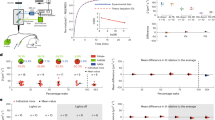Abstract
IF neuroamines modulate perception and affect, as implied in much of the literature, the behavioural effects of marihuana may be mediated by alterations of brain amine mechanisms, Even in large doses (5–500 mg kg−1), Δ9-tetra-hydrocannabinol (Δ9-THC) produces only relatively small changes in the brain levels and turnover of serotonin1–3, catecholamines2–4 and acetylcholine5. We report here biochemical and behavioural experiments suggesting a role for endogenous 2-phenylethylamine (PEA) in the action of Δ9-THC. PEA may be one of the neuromodulators involved in wakefulness, arousal and excitement6,7, and it is the precursor of phenylethanolamine, a putative neurotransmitter8. PEA is present in human8 and animal9 brain; monoamine oxidase B plays a major role in the metabolism of PEA whereas monoamine oxidase A is responsible for the deamination of noradrenaline and serotonin10. The observations that the urinary excretion of PEA is decreased in patients with endogenous depression11–13 and that in animals brain levels of PEA are increased by antidepressive treatments [monoamine oxidase inhibitors (MAOIs), imipramine, electroshock7,9,14] suggest that this amine is important in modulating affect.
This is a preview of subscription content, access via your institution
Access options
Subscribe to this journal
Receive 51 print issues and online access
$199.00 per year
only $3.90 per issue
Buy this article
- Purchase on Springer Link
- Instant access to full article PDF
Prices may be subject to local taxes which are calculated during checkout
Similar content being viewed by others
References
Ho, B. T., Taylor, D., Englert, L. F., and McIssaacs, W. M., Brain Res., 31, 233 (1971).
Holtzman, D., Lovell, R. A., Jaffee, J. H., and Freedman, D. X., Science, N.Y., 163, 1464 (1969).
Welch, B. L., Welch, A. S., Messiha, F. S., and Berger, H. J., Res. Commun. chem. Pathol., 2, 382 (1971).
Maitre, L., Staehelin, M., and Bein, H. J., Agents and Actions, 1, 136 (1970).
Domino, E. F., Ann. N.Y. Acad. Sci., 191, 166 (1971).
Fischer, E., Ludmer, R. I., and Sabelli, H. C., Acta physiol. Lat. Amer., 17, 15 (1967).
Sabelli, H. C., and Giardina, W. J., in Chemical Modulation of Brain Function, (edit. by Sabelli, H. C.), (Raven Press, New York, 1973).
Inwang, E. E., Mosnain, A. D., and Sabelli, H. C., J. Neurochem., 20, 1469 (1973).
Sabelli, H. C., Giardina, W. J., Mosnaim, A. D., and Sabelli, N. H., Acta physiol. pol., 24, 33 (1973).
Fuller, R. W., and Roush, B. W., Arch. Int. Pharmacodyn., 198, 270 (1972).
Fischer, E., Heller, B., and Miro, A. N., Arzneim.-Forsch., 18, 1486 (1968).
Boulton, A. A., and Milward, L., J. Chromatog., 57, 287 (1971).
Mosnaim, A. D., Inwang, E. E., Sugerman, J. H., DeMartini, W. J., and Sabelli, H. C., Biol. Psychiat., 6(3), 235 (1973).
Fischer, E., Spatz, H., Heller, B., and Reggiani, H., Experientia, 28, 307 (1972).
Mosnaim, A. D., and Inwang, E. E., Anal Biochem., 54, 561 (1973).
Mosnaim, A. D., Inwang, E. E., and Sabelli, H. C., Biol. Psychiat. (in the press).
Isbell, H., and Jasinski, D. R., Psychopharmacologia, 14, 115 (1969).
Sabelli, H. C., Pedemonte, W. A., Whalley, C., Mosnaim, A. D., and Vazquez, A. J., Life Sci. (in the press).
Brodie, B. B., and Shore, P. A., Ann. N.Y. Acad. Sci., 66, 631 (1957).
Jouvet, M., Science N.Y., 163, 32 (1969).
Koella, W. P., Neurosci. Res., 2, 229 (1969).
Truitt, E., and Anderson, S. M., Acta Pharmaceutica Suecica, 8, 696 (1971).
Vazquez, A. J., and Sabelli, H. C., in Drug Addiction: Behavioral Aspects, (edit. by Singh, J.), (Futura Press, New York, in the press).
Author information
Authors and Affiliations
Rights and permissions
About this article
Cite this article
SABELLI, H., VAZQUEZ, A., MOSNAIM, A. et al. 2-Phenylethylamine as a possible mediator for Δ9-tetrahydrocannabinol-induced stimulation. Nature 248, 144–145 (1974). https://doi.org/10.1038/248144a0
Received:
Revised:
Issue Date:
DOI: https://doi.org/10.1038/248144a0
This article is cited by
-
Analgesic Effects of β-Phenylethylamine and Various Methylated Derivatives in Mice
Neurochemical Research (2014)
-
Rat Brain-Uptake Index for Phenylethylamine and Various Monomethylated Derivatives
Neurochemical Research (2013)
-
Behavioral and electrophysiological effects of phenylethanolamine and 2-phenylethylamine
Psychopharmacologia (1975)
Comments
By submitting a comment you agree to abide by our Terms and Community Guidelines. If you find something abusive or that does not comply with our terms or guidelines please flag it as inappropriate.



